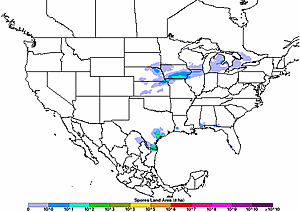Integrated Aerobiology Modeling System (IAMS) for Forecasting the Aerial Dispersal of Soybean Rust Spores throughout North America

Simulated Daily wet deposition for August 24, 2007
Shortly after soybean rust was identified in South America, the USDA began to assess the potential for transport of P. pachyrhizi into North America. As part of this effort, they funded the development of the Integrated Aerobiology Modeling System (IAMS) to assess the risk that viable spores could be blown to the U.S., probable atmospheric transport pathways for the pathogen, and when and where deposition of spores was most likely to occur (Isard et al. 2005). Output from the IAMS became the basis for the USDA Economic Research Service assessment of the potential impact of soybean rust on U.S. agriculture (Livingston et al. 2004), which in turn stimulated an unprecedented effort by the USDA to prepare for the incursion of P. pachyrhizi (Roberts et al. 2006).
IAMS simulations, conducted immediately after the North American discovery of soybean rust, showed that winds associated with Hurricane Ivan had the potential to transport rust spores from northern South America, including the infected Rio Cauca source area in Colombia, to the southeastern U.S. (Isard et al. 2005). A map showing the IAMS prediction of where viable spores were deposited in rainfall was provided to the USDA Soybean Rust Rapid Response Team in early November 2004, to guide field scouting sorties for the disease. Within three weeks of the initial discovery, P. pachyrhizi was confirmed in diseased plant tissue from late-planted soybean fields and wild kudzu (Pueraria lobata) plants at multiple locations within or immediately adjacent to the region of spore deposition predicted by the IAMS (see Fig. 5 in Isard et al. 2005).
During the 2004/2005 winter, an Information Technology (IT) platform was constructed to integrate soybean rust monitoring, databasing activities, IAMS output, and communications to stakeholders into a state-of-the-art cyberinfrastructure (Isard et al., 2006). Since that time, IAMS simulations were conducted daily during the North American soybean growing season and along with information from a nationwide observation network provided the basis for communications by plant pathologists to farmers.
The IAMS is configured in a modular format and includes spore release and escape from the plant canopy, atmospheric transport, mortality due to exposure to solar radiation, wet and dry deposition of spores, host development at destinations, and disease progress on these hosts. Together the modules predict the progression and intensity of an epidemic in an impacted region and when the spatial unit becomes a source of P. pachyrhizi spores for further atmospheric spread. The domain of the model is 7.5 - 50 oN latitude and 60-130 oE longitude with a grid resolution of 0.083 degrees (~ 10 km) and a vertical resolution defined by the standard pressure levels (1000, 950, 900, 850, 800, 700, 600, 500 hPa). Thus there are as many as eight, 3-dimensional "airscape units" or air layers above each grid cell on the ground. The time step for model simulations is 1 h. The wind speed and direction, air temperature, humidity, and cloud cover data used in IAMS simulations are output from U.S. National Oceanic and Atmospheric Administration (NOAA) National Center for Environmental Prediction (NCEP) models including the Rapid Update Cycle Forecast, North American Mesoscale, and the Global Forecast System. Hourly precipitation data are obtained from the U.S. National Weather Service (NWS) NEXRAD Stage IV radar precipitation model. Details of each of the modules can be found in Isard et al. (in press)
Isard, S. A., Gage, S. H., Comtois, P. & Russo, J. M. (2005). Principles of aerobiology applied to soybean rust as an invasive species. BioScience, 55, 851-862.
Isard, S. A., Russo, J. M. & DeWolf, E. D. (2006b). The establishment of a national pest information platform for extension and education. Online, Plant Health Progress, doi:10.1094/PHP-2006-0915-01-RV. Retrieved August 1, 2007, from http://www.plantmanagementnetwork.org/php/elements/sum2.asp?id=5508
Isard, S. A., Russo, J. M. & Ariatti, A., in press. Aerial transport of soybean rust spores into the Ohio river valley during September 2006. Aerobiologia.
Livingston, M., Johansson, R., Daberkow, S., Roberts, M., Ash, M. & Breneman, V. (2004). Economic and policy implications of wind-borne entry of Asian soybean rust into the United States. Electronic Outlook Report from the U.S. Department of Agriculture Economic Research Service, OCS-04D-02. Retrieved August 1, 2007, from http://www.ers.usda.gov/publications/OCS/APR04/OCS04D02/
Roberts, M. J., Schimmelpfennig, D., Ashley, E. & Livingston, M. (2006). The value of plant disease early-warning systems: A case study of USDA's soybean rust coordinated framework. United States Department of Agriculture, Economic Research Service, Economic Research Report No. 18. Retrieved August 1, 2007 from http://www.ers.usda.gov/publications/err18/err18fm.pdf

